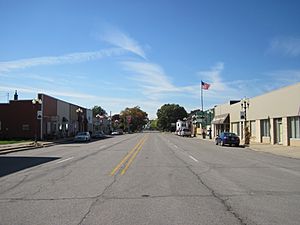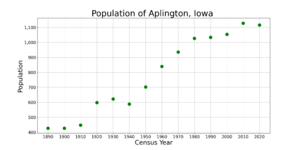Aplington, Iowa facts for kids
Quick facts for kids
Aplington, Iowa
|
|
|---|---|
 |
|

Location of Aplington, Iowa Mayor-Tim Pollock
|
|
| Country | |
| State | |
| County | Butler |
| Area | |
| • Total | 0.73 sq mi (1.90 km2) |
| • Land | 0.73 sq mi (1.90 km2) |
| • Water | 0.00 sq mi (0.00 km2) |
| Elevation | 974 ft (297 m) |
| Population
(2020)
|
|
| • Total | 1,116 |
| • Density | 1,518.37/sq mi (586.53/km2) |
| Time zone | UTC-6 (Central (CST)) |
| • Summer (DST) | UTC-5 (CDT) |
| ZIP code |
50604
|
| Area code(s) | 319 |
| FIPS code | 19-02395 |
| GNIS feature ID | 0454209 |
Aplington is a city located in Butler County, Iowa, United States. In 2020, the city had a population of 1,116 people.
Contents
History of Aplington
Aplington was started in the summer of 1857. It was planned by Thomas Nash, R. R. Parriott, Zenas Aplington, and Theodore A. Wilson. Before the town was planned, Charles Savage had built the first house there.
Aplington became an official city in the 1880s. It grew into a busy trading center. The town was named after Zenas Aplington, who owned some of the land. He lived in Illinois and never lived in Aplington. Zenas Aplington cared about the town until he died while serving in the American Civil War.
Early Businesses in Aplington
The first building in Aplington was built by Zenas Aplington in 1856. It was a general store. George W. Hunter was the first merchant, selling goods for about a year. Later, Isaac Hall opened a general store in the same building in 1864.
Charles Savage's father was an early settler. He set up the first blacksmith shop in the southern part of Butler County. William Bisbee also opened a blacksmith shop in 1857.
The first hotel in Aplington was built by Mrs. Rachel Quinn in 1858. It changed owners a few times. Even older buildings provided a place for travelers to stay and eat.
When the Illinois Central Railroad arrived in 1865, Alonzo McKey built the first grain elevator. Grain elevators are tall buildings used to store grain. More elevators were built over the years by different owners.
Aplington was also known for its mills and a creamery. In 1872, a stock company started building a mill. It faced some delays but eventually began running in 1877. The Spring Hill Creamery opened in 1881. It processed large amounts of milk from nearby farms. Dairying became a very important business in the area.
Geography
Aplington is located at 42.582543 degrees north latitude and -92.882530 degrees west longitude.
According to the United States Census Bureau, the city covers a total area of about 0.83 square miles (2.15 square kilometers). All of this area is land.
Population Information
| Historical populations | ||
|---|---|---|
| Year | Pop. | ±% |
| 1890 | 427 | — |
| 1900 | 427 | +0.0% |
| 1910 | 448 | +4.9% |
| 1920 | 598 | +33.5% |
| 1930 | 622 | +4.0% |
| 1940 | 588 | −5.5% |
| 1950 | 702 | +19.4% |
| 1960 | 840 | +19.7% |
| 1970 | 936 | +11.4% |
| 1980 | 1,027 | +9.7% |
| 1990 | 1,034 | +0.7% |
| 2000 | 1,054 | +1.9% |
| 2010 | 1,128 | +7.0% |
| 2020 | 1,116 | −1.1% |
| Source: and Iowa Data Center Source: |
||
The population of Aplington has changed over the years. The chart to the left shows how the number of people living in Aplington has grown since 1890.
2020 Census Data
In 2020, there were 1,116 people living in Aplington. There were 441 households and 300 families. The city had about 1,519 people per square mile. There were 504 homes in total.
Most of the people in Aplington (96.9%) were White. A small number were Black, Native American, or Asian. About 0.9% of the population was Hispanic or Latino.
The average age in Aplington was 41.3 years old. About 26.2% of residents were under 20 years old. About 23.9% were 65 years or older. The population was 47.8% male and 52.2% female.
2010 Census Data
In 2010, Aplington had 1,128 people. There were 461 households and 308 families. The population density was about 1,359 people per square mile.
Most residents (99.2%) were White. A very small number were African American or Asian. About 0.3% of the population was Hispanic or Latino.
The average age was 43.3 years. About 25.4% of residents were under 18. About 26.2% were 65 or older. The population was 46.0% male and 54.0% female.
Education
Students in Aplington attend schools in the Aplington–Parkersburg Community School District. The Aplington Elementary/Middle School is located in Aplington. The Aplington–Parkersburg High School is in Parkersburg. This school district was formed on July 1, 2004. It combined the Aplington and Parkersburg school districts.
Notable People
Aplington has been home to some interesting people:
- Betty Lee Babcock — A politician and businesswoman. She was the wife of Montana Governor Tim M. Babcock.
- Jared DeVries — A former professional football player for the Detroit Lions.
- Darian DeVries — A college basketball coach. He is currently the head coach for the West Virginia Mountaineers. He used to coach the Drake Bulldogs.
See Also
 In Spanish: Aplington para niños
In Spanish: Aplington para niños


